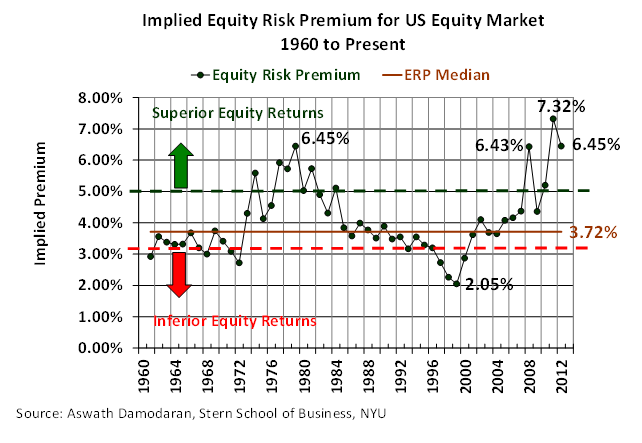The Equity Risk Premium Is Still High
Post on: 4 Август, 2015 No Comment

Summary
- The stock market remains attractively valued.
- The equity risk premium remains high by historical standards.
- The size of the premium reflects the low yields on offer in the bond market.
At the beginning of each month, Professor Aswath Damodaran at NYU publishes his estimate of the implied equity risk premium as of the first day of the month. His estimates go back to 1961. Today he published his estimate for July 1, 2014, which is 5.4%. How should we interpret this number?
The 53-year range for Damodaran’s ERP is 2.0% to 7.7%, and the eyeball median is between 3% and 4%. Since the Crash, the range has been between 4.4% and 7.7% (the all-time high, set in March 2009 and again in October 2011). The current number is the highest it has been since last October.
My personal view is that when the ERP is above 4%, the stock market offers an adequate risk premium, and when it is below 4% it is less compelling and more risky. The all-time low was set in 1999 at 2.0%. The stock market was highly overvalued at that time, and it took 15 years for the real S&P 500 index to return to its 1999 high.
Fernando Duarte and Carlo Rosa at the New York Fed published a paper on the ERP in January: The Equity Risk premium: A Consensus of Models. The authors concluded that:
There is broad agreement across models that the ERP has reached historical heights [as of mid-2013] even when the models are substantially different from each other and use more than one hundred different economic variables.
The ERP is high at all foreseeable horizons because Treasury yields are unusually low at all maturities. In other words, the term structure of equity premia is high and flat because the term structure of interest rates is low and flat. Current and expected future dividend and earnings growth play only a minor role.
A high ERP caused by low bond yields indicates that a stock market correction is likely to occur only when bond yields start to rise.
We should no longer rely on traditional indicators of the ERP like the price-dividend or price-earnings ratios, which all but ignore the term structure of risk-free rates.
The current high levels of the ERP are unusual in that we are not currently in a recession and we have just experienced an extended period of high stock returns. During previous periods, the ERP has always decreased during periods of sustained high realized returns. It is unusual for the ERP to be at its present level in the current stage of the business cycle, especially when expectations are that it will continue to rise over the next three years.
Our analysis provides evidence that is consistent with a bond-driven ERP: expected excess stock returns are high not because stocks are expected to have high returns, but because bond yields are exceptionally low.
The key take-away from their paper is that the stock market offers an attractive risk/return relationship not because of expected earnings growth, but instead because low interest rates justify a high P/E ratio. A simple way to look at it is to compare the P/E of the 10-year Treasury bond with that of the S&P 500. The current P/E for the bond market is 40x, while the P/E for the stock market is 20x — even though corporate earnings grow and bond interest doesn’t.
One might argue that both stocks and bonds are overvalued, perhaps due to the zero funds rate and quantitative easing. However, I see no evidence that bond yields are artificially low. Bond yields are historically low because inflation expectations are historically low. Despite unprecedented monetary stimulus, both expected and observed inflation have remained low.
Admittedly, the bond and stock markets are vulnerable to an inflation shock, but I don’t expect one. Money growth remains in the mid-single digits, velocity continues to decline, overall credit growth is modest. and nominal growth is at a recessionary level. Higher oil prices are deflationary, not inflationary.
I am aware of the argument that true inflation is much higher than reported, but this requires a level of paranoia that is neurotic and not analytic. Inflation is low, which is why the prices of gold and silver have been falling for almost three years. Not only is price inflation low, but also wage growth is currently flat.
Investment Conclusion
The stock market has offered investors a historically high risk premium since the Crash. While the current premium is below the all-time highs following the Crash, it remains elevated at all horizons and does not depend upon expected earnings growth. Higher inflation and bond yields would reduce the premium, but I see the risk of an inflation shock as low. Consequently, I believe that the stock market remains attractively valued at current prices.
Disclosure: The author has no positions in any stocks mentioned, and no plans to initiate any positions within the next 72 hours. The author wrote this article themselves, and it expresses their own opinions. The author is not receiving compensation for it. The author has no business relationship with any company whose stock is mentioned in this article.
Additional disclosure: I am long stocks and bonds.














